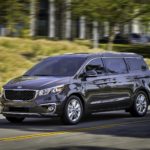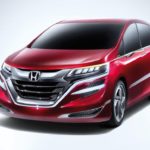The very first hybrid minivan arrives in America.
When the first Chrysler minivans hit the marketplace in 1984, they changed family transportation. The front-wheel-drive vans used carlike flight and handling in a compact shape that protected a great deal of the space and practicality of bigger vans and station wagons. It was a dangerous proposition at the time as Chrysler needed a mass-market success to save itself from personal bankruptcy. The choice to roll the dice has considering that gone down in history as one that not only saved the business but drastically changed the automotive landscape, with minivans ending up being the go-to household vehicle up until the more current rise of the SUV.
Now Chrysler discovers itself in a probably more stable financial position. (Again, probably.) The brand is making another attempt at modernizing household transportation by introducing a plug-in-hybrid variation of its all-new Pacifica minivan. Not just will it be the very first of its kind used on American coasts when it strikes dealer lots in early 2017, however it also maintains most of the space and usefulness of the nonhybrid model.
Under the hood is the familiar 3.6-liter V-6 from the basic Pacifica, but it has actually been modified for hybrid task with new pistons, camshafts, and valves, and it embraces the Atkinson combustion cycle for enhanced fuel effectiveness. Under the second-row floor (where the Stow ‘n Go seats could otherwise be stowed away) is a 16.0-kWh lithium-ion battery pack that Chrysler quotes will supply up to 30 miles of pure-electric driving prior to the gasoline engine is needed; two hours on a 240-volt connection must net a full charge (14 hours is required on 120 volts). All this is par for the course when it comes to plug-in-hybrid powertrains, however it’s the Pacifica hybrid’s eFlite electrically variable transmission that sets it apart.
Many hybrid drive systems use two Air Conditioner motor/generators for propulsion, to recapture energy throughout coasting and braking and to regulate the engine’s drive ratio, and the new eFlite transaxle is no different. It was developed in-house by Fiat Chrysler engineers and utilizes a planetary gearset and a one-way clutch to direct torque from the 2 electrical motors and the engine to the differential. Chrysler says the system is more compact than competing setups and boasts greater performance. Brand name authorities are being coy about it, but the system’s compact size ought to make it much easier to adjust the powertrain to a range of future products within the FCA family. For the Pacifica hybrid, Chrysler is estimating city fuel-economy ratings as high as 80 MPGe.
The Pacifica hybrid will be offered in Premium and Platinum trim levels. We had the ability to sample a Platinum model on a route up the Pacific Coast Highway to Malibu and through the mountains near Santa Monica. Southern California is a fitting location to release the hybrid minivan, not even if its name stimulates a yearning for warm ocean waters, but due to the fact that of the area’s fight with air contamination and crippling traffic. Plug-in-hybrid automobiles such as the Pacifica hybrid qualify for unique access to California’s high-occupancy-vehicle (HOV) highway lanes even when bring just the motorist, making them especially attractive to commuters.
In the city, the Pacifica hybrid moves around its approximated 5000 pounds with authority, with the electrical drivetrain doing the bulk of the heavy lifting. Pulling into heavy midday traffic on Santa Monica Boulevard was no problem at all. The approximated 30-mile electric-only range seems relatively accurate; we made it that far, offer or take a mile or two, before the electrons ran out. On undulating mountain roadways, the hybrid powertrain felt capable and never overtaxed, even on long uphill grades. Regenerating as we drifted pull back, we had the ability to coax 7 extra miles of electric-only travelling for use on our trip house. After a little less than 100 miles, the Pacifica’s onboard journey computer approximated that we had actually balanced 30.6 mpg– okay, specifically considering the basic Pacifica’s EPA combined ranking of 22 mpg. (The EPA rankings for the hybrid aren’t yet available.).

The hybrid’s flight and handling are similar as that of the gas-powered Pacifica. Chrysler engineers increased spring rates to accommodate the hybrid’s claimed 613-pound weight gain, and it appears to have actually worked, as the hybrid’s smooth trip and positive body control resembled the standard design’s. Just like the nonhybrid, steering is light and vague on-center, however this minivan is easy to maneuver around town and needs couple of corrections to keep tracking directly on the highway.
Not whatever is too arranged as in the regular model, though. The brake pedal feels limp and nonlinear underfoot, making it challenging to use the correct amount of braking power. And the gas engine, while smooth and remarkably peaceful when travelling, sends an unrefined shiver into the cabin when kicking on throughout heavy throttle departures. We picture that these issues eventually will fade into the background for owners, but they did take us a part of the day to adapt to and might be enhanced.
Only subtle changes were made to the outside styling, such as the wave-textured front grille, model-specific 18-inch aluminum wheels, and teal-accented Chrysler logos. The Pacifica hybrid’s interior will recognize to those who have seen the regular van; it has the exact same soft-touch plastics, wide variety of USB ports, thoughtful positioning of cupholders and storage bins, and Chrysler’s easy-to-use Uconnect touchscreen infotainment system. A driver-facing 7.0-inch digital instrument cluster is basic and includes hybrid-specific info such as operating mode, overall range, and eco-friendly driving pointers.
Selecting the hybrid design does include one huge compromise, which we pointed out previously: Chrysler’s signature Stow ‘n Go second-row seats aren’t readily available considering that the underfloor seat-storage cavities are filled with battery cells. While not perfect, this does a minimum of rectify among our main gripes about the standard Pacifica– second-row seat comfort. Since the middle seats no longer need to fold compactly to fit under the flooring, they boast more cushioning and are even more comfy.
The Premium trim, starting at $43,090, features goodies such as heated leather seats for first-row travelers, remote start, three-zone automated climate control, second-row captain’s chairs, and a power liftgate. Platinum models will command a $46,090 sticker price and include ventilated seats for front-row travelers, a heated two-tone steering wheel, in-dash navigation, and hands-free moving side doors. A single-screen, overhead DVD player ($ 895) is the Premium model’s only alternative. Platinum models come basic with a dual-touchscreen rear-seat home entertainment system with integrated video games for the kids and provide an optional panoramic sunroof for $1795. The Chrysler Pacifica hybrid will receive a $7500 federal tax credit and may qualify for additional state and regional incentives, which bring the overall expense down substantially and, in the case of the Premium trim, within just $100 of a gasoline-powered Pacifica Touring-L with similar equipment.
While the hybrid powertrain isn’t really a discovery, it’s a satisfying addition to the Pacifica lineup– and it could spur competitors such as Honda (which already has a hybrid minivan on sale in Japan) and Toyota to use hybrid minivans in the United States. Just as it finished with the initial minivans of the 1980s, Chrysler is raking fresh ground, and the car-buying public stands to benefit.





